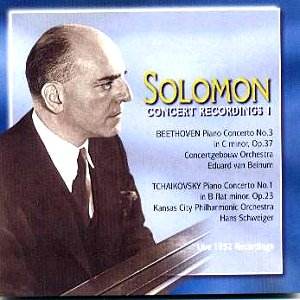This is the first volume in a series devoted to live
Solomon performances and will fill his many admirers with anticipation
and enthusiasm. That the two concert performances here replicate two
of his best-known interpretations need not come as a disappointment.
Solomon recorded both the Beethoven C minor and the Tchaikovsky B flat
twice; the former with Boult in 1944 and Menges in 1956, the Tchaikovsky
with Harty in 1929, one of his first recordings, and again in 1949 with
Issay Dobrowen. These live performances date from a period of intense
travel, the Tchaikovsky, in Kansas, from the beginning of 1952 and the
Beethoven, recorded in Amsterdam, from the end; book-ending assiduous
and ceaseless performing.
The Beethoven is in good sound; it opens without particular
opulence but there is depth in bass sonorities and a just balance between
soloist and orchestra. There are some signs of a bronchial Dutch audience
but these are part of the on-the-wing performance. There are some little
differences between the now-three extant performances Solomon has left
us. In all three recordings his approach to the finale was essentially
stable; in the slow movement there is little difference in tempo between
van Beinum and Boult though with Herbert Menges (himself a pianist)
Solomon expands more. In the Allegro con brio his van Beinum and Menges
timings are almost identical; Boult was somewhat fleeter and inclined
to drive faster, inflecting the opening orchestral introduction, for
example, with myriad felicities. In Amsterdam there is sovereign clarity
in passagework in the opening movement. Dramatic and purposeful, there
is splendid unanimity between soloist and conductor with Solomon’s patrician
refinement as ever a thing of wonder. His control of dynamic contrast
and colouristic acumen are imperishable features of a thoroughly convincing
first movement. As was invariably the case he plays the Clara Schumann
cadenza. The Largo unfolds with measureless generosity. The Concertgebouw
woodwinds are on especially expressive form – the principal flute particularly
so – and van Beinum shapes the movement with real understanding (there
are a couple of scratches on the acetate in this movement but they are
of very little account). The tonal weight Solomon employs and his shades
of chordal colour and depth are as impressive as the way in which van
Beinum lightens string tone, where earlier the basses and cellos had
been strong and expressive. The finale goes with easy fluency, variegations
of tone and perfectly animated runs coalescing with the quietly humorous
spirit Solomon always engendered here. The close is brilliantly spirited
and well deserves the animated applause that night in Amsterdam.
The Tchaikovsky is, as Bryan Crimp justly notes, a
more outward-going and obviously virtuosic performance than the magisterial
1929 and 1949 commercial traversals. That said there is no trace of
ostentation or vulgarity here. Instead there is dashing technique in
the first movement with plenty of panache. The Kansas woodwinds certainly
pipe up strongly in this movement and one can savour the adrenalin rush
that Solomon could impart, from 7.00 onwards. Incendiary stuff. The
Prestissimo section of the Andantino semplice is rippling and deliciously
fleet, the return to the tempo primo negotiated well. It’s true that
the Kansas City orchestra is not the finest and also that there is some
congestion in the sound here and there but nothing enough to spoil pleasure
in Solomon’s drive and conviction. When it comes to the finale he does
drop one or two notes but this is heat of the moment playing even at
his accustomed tempo and nothing derails him from a triumphant conclusion.
The documentation is excellent and Crimp’s notes succinct.
We can look forward with confidence to the second volume of this series.
Both Brahms Concertos exist in off-air performances and it would be
good to hear Solomon’s speaking voice – he was recorded in interviews
on tour. Admirers await the next instalment with keen interest.
Jonathan Woolf
